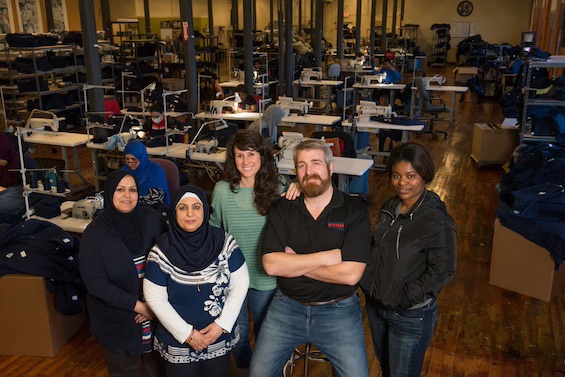
Estimated reading time: 5 minutes
Since NAFTA took effect in 1994, “more than 60,000 American manufacturers permanently shut their doors. . . In textiles alone, more than a million manufacturing jobs evaporated between 1990 and 2019.” That fact, brought starkly to light in Rachel Slade’s powerful new book, Making It in America, frame the challenge faced by Ben and Whitney Waxman when they set out in 2015 to manufacture 100 percent American-sourced cotton hoodies with union labor. Their struggle to build a business is a superb example of the movement underway in the USA today to bring back manufacturing.
Swimming against the tide of globalization
The Waxmans “founded American Roots with a simple plan,” Slade writes. “Together, they would bring apparel manufacturing back to America. They would be uncompromising in their commitment to domestic sourcing and the welfare of their employees . . . never pay themselves more than four times their lowest worker’s wage , , , build a legacy company that they could someday bequeath to their employees or perhaps their own children . . . [and] build a community around making.” And in Making It in America, Slade shows just how difficult that challenge has proved to be.
Making It in America: The Almost Impossible Quest to Manufacture in the U.S.A. (And How It Got That Way) by Rachel Slade (2024) 352 pages ★★★★★

One determined couple’s struggle to bring back manufacturing
The Waxmans’ company, American Roots, stands out from the other four thousand new US manufacturing companies that launched the same year. Because Ben Waxman is no run-of-the-mill entrepreneur. For years, he was an organizer in the uppermost reaches of the AFL-CIO. In fact, he worked closely with Rich Trumka, who led American labor from 2009 until his death in 2021. And Waxman left the AFL-CIO with a ferocious commitment to the labor movement. American Roots has been unionized since Day One. And most of its customers are union locals. It’s not too much to say that the company only survived because of its continuing support from the labor movement.
Now, that fact doesn’t detract in any way from the Waxman’s’ heroic effort to build their business. Even with a powerful commitment from labor, they faced what seemed insurmountable obstacles. And their pivot in 2020 from cotton hoodies to masks and shields against covid was nothing short of brilliant. Theirs is the quintessential American story. As much as any character out of Horatio Alger, they pulled themselves up by their bootstraps.
The steep price of globalization
Globalization has been a boon to China, Vietnam, Bangladesh, Mexico, the Philippines, and many other struggling countries around the world where US manufacturing jobs have gravitated. But its impact on the American economy has been mixed at best. It’s true that US consumers now pay lower prices on many of the things we buy. But the durability of those goods has often declined sharply. For example, Slade reports, “The quality of the garments we wear and discard has dropped so low that 40 percent of [used clothing] shipments to Ghana end up in landfill, or worse, on the country’s beaches.”
However, the greatest impact of globalization in the USA has been to lower the quality of life for millions of Americans and widen the gap between rich and poor. Because as manufacturing has fallen, millions of union jobs have been lost. (In 1993, the year before NAFTA, union jobs represented 15.7% of the workforce. Thirty years later, they accounted for only ten percent.) That shift has contributed in a major way to the stagnation of working people’s wages.
For example, according to the Federal Reserve Bank of St. Louis, the median annual wage of high school graduates employed full-time in 2000 was $28,000. Now, in 2024, it’s only $25,700. Meanwhile, over that same 25-year period, median household income in the US has risen from $67,500 to $74,600. And that rise reflects the enormous shift of resources from working families to the growing ranks of the superrich. Because over roughly that same period the top 1% of earners captured twenty-six percent of the country’s wealth versus seventeen percent at the beginning—a gain of nine percent, or more than half again as much. Globalization isn’t the only factor accounting for this—but it’s certainly played a role.
About the author

Rachel Slade’s bio on her author website reads in part as follows: “Rachel Slade spent a decade in the city magazine trenches at Boston magazine—first as the design editor, ultimately as executive editor. Her two-part story about Boston’s secretive planning and development agency won national awards and laid the groundwork for Mayor Michelle Wu’s sweeping reforms to the city’s planning processes.
“She earned her BA in political science from Barnard College and a Master of Architecture from the University of Pennsylvania. She splits her time between Brookline, Massachusetts, and Rockport, Maine.” Making It in America is her second book.
For related reading
I’ve reviewed two other excellent books on the impact of globalization:
- Factory Man: How One Furniture Maker Battled Offshoring, Stayed Local — and Helped Save an American Town by Beth Macy (Understanding globalization, from the ground up)
- Ninety Percent of Everything: Inside Shipping, The Invisible Industry That Puts Clothes on Your Back, Gas in Your Car, and Food on Your Plate by Rose George (What makes globalization work?)
You’ll find other related books here:
- My 10 favorite books about business history
- Top 20 popular books for understanding American history
- Gaining a global perspective on the world around us
And you can always find my most popular reviews, and the most recent ones, on the Home Page.


























